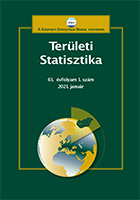A magyarországi területi bérkülönbségek összetevői
Components of regional wage differences in Hungary
Author(s): László Czaller, József Nemes NagySubject(s): Social Sciences, Economy, Geography, Regional studies
Published by: Központi Statisztikai Hivatal
Keywords: wage, labour markets; worker composition; wage inequalities; district
Summary/Abstract: The authors investigated in this study how much of the wage differences on workers’ and district levels are explained by employee and employer characteristics and by differences in regional attributes. For this purpose the Ministry of Information and Technology’s annual wage survey and income statements from the OPTEN database have been used. Results show that individual characteristics of workers, in particular the occupational classification of the job and their educational attainment play a leading role in explaining the wage differentials observed on individual level. The explanatory power of employer-level characteristics is secondary, however it still exceeds the combined contribution of regional characteristics, estimated at 1-2% at most. When examining district-level average wage differentials, the composition of employees and employers in districts is responsible for three quarters of spatial wage inequalities. By removing the composition effect, the standard deviation of average gross monthly wages between districts is reduced to half. These results show that in addition to a territorial approach, policy interventions aimed at developing hu-man capital also play an important role in promoting the catching-up of dis-advantaged regions.
Journal: Területi Statisztika
- Issue Year: 64/2024
- Issue No: 03
- Page Range: 380-408
- Page Count: 29
- Language: Hungarian

